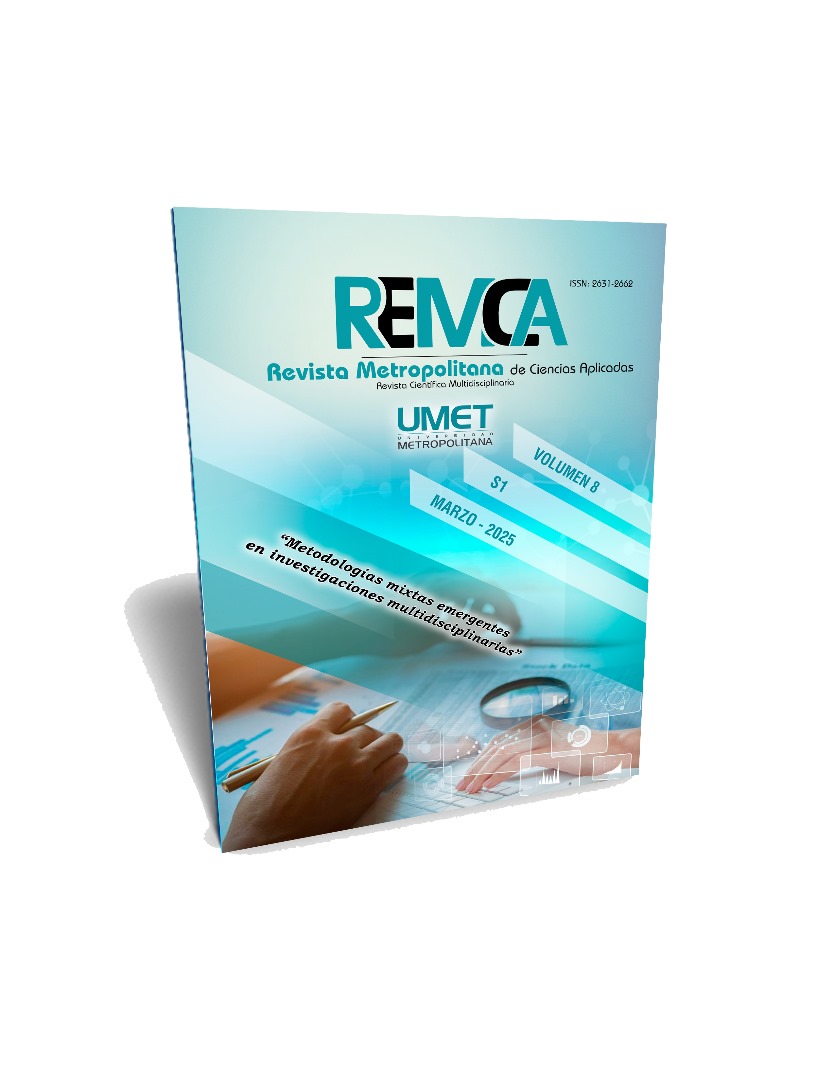Comportamiento de propiedades físicas, químicas y biológica del suelo en sistemas de producción agrícola
DOI:
https://doi.org/10.62452/se591c34Palavras-chave:
Degradación del suelo, erosión y compactación, actividad antrópica, sistemas de producciónResumo
El suelo es un recurso natural no renovable que garantiza la nutrición vegetal, la producción agrícola y el sustento alimenticio de una población en contante crecimiento. El objetivo del trabajo fue evaluar el comportamiento de propiedades físicas, químicas y biológica en agroecosistemas establecidos en la granja Santa Inés, El Oro, Ecuador. En cinco agroecosistemas (banano, maíz, pastos, cacao y bosque) seleccionados, identificados y georreferenciados previamente se efectuó la toma de muestras de suelo a tres profundidades del perfil (0-15, 15-30 y 30-45 cm). El estado actual de la degradación del suelo fue estimado por escalamiento óptimo a partir de los valores obtenidos en densidad real (Dr), pH, contenidos de N total, P asimilable, K, Ca, Mg intercambiables, CE, CIC, MO y las categorías de clase textural. El manejo intensivo y continuado en agroecosistemas donde no se aplican alternativas para la conservación y mejoramiento del suelo provocan el incremento de la compactación y disminución del contenido de MO, CIC y pH, así como, su aptitud para producir producciones de forma sostenida. El manejo agrícola de agroecosistemas provoca un impacto negativo en las propiedades físicas, químicas y biológica del suelo cuando no se aplican prácticas que contribuyan a su conservación y mejoramiento.
Downloads
Referências
Amaro, E. J., Marquez, E., & Llanes, J. M. (2019). Diagnóstico inicial de la evolución de un suelo degradado. Avances, 21(1). https://www.redalyc.org/journal/6378/637869112010/637869112010.pdf
Castro, A., Delgado, D. M., González, R. (2022). La degradación del suelo, impactos y contexto normativo. https://librosesmic.com/index.php/editorial/catalog/download/92/88/2299?inline=1 CEPAL. (2012). Diagnóstico de la Estadistica del Agua en Ecuador.
Ecuador. Agencia de Regulación y Control Fito y Zoosanitario. (2022). Sitio oficial. https://www.gob.ec/arcfz
Ecuador. Instituto Nacional de Meteorología e Hidrología. (2016). Boletín Climatológico Anual. https://www.inamhi.gob.ec/meteorologia/boletines/bol_sem.pdf
Ecuador. Ministerio de Agricultura y Ganadería. (2020). Resumen Ejecutivo de los Diagnósticos Territoriales del Sector Agrario. https://doi.org/10.2307/j.ctv17hm8pq.4
Garrido, L. A. (2020). Efectos del bocashi en la producción de plantas de Calathea lutea Schult (Bijao) bajo condiciones de vivero en Tingo María. (Trabajo de titulación). Universidad Nacional Agraria de la Selva.
Geissen, V., López De Llergo-Juárez, J. G., Galindo-Alcántara, A., & Ramos-Reyes, R. (2008). Erosión Superficial y Carstificación en Macuspana, Tabasco, Sureste De México Superficial Soil Losses and Karstification in Macuspana, Tabasco, Southeast of México. Agrociencia, 42, 605–614. http://www.scielo.org.mx/pdf/agro/v42n6/v42n6a1.pdf
Intergovernmental Technical Panel on Soils. (2020). Towards a definition of soil health. In Soil Science Society of America Journal. https://www.fao.org/3/cb1110en/cb1110en.pdf
Lanz, B., Dietz, S., & Swanson, T. (2018). The Expansion of Modern Agriculture and Global Biodiversity Decline: An Integrated Assessment. Ecological Economics, 144, 260–277. https://doi.org/10.1016/j.ecolecon.2017.07.018
Liu, H., Zak, D., Rezanezhad, F., & Lennartz, B. (2019). Soil degradation determines release of nitrous oxide and dissolved organic carbon from peatlands. Environmental Research Letters, 14(9). https://doi.org/10.1088/1748-9326/ab3947
López, G., Muñoz, D., Hernández, M., Soler, A., & López, G. (2008). Impacto De La Pérdida De La Vegetación Sobre Las Propiedades De Un Suelo Aluvial. Terra Latinoamaericana, 27, 2–10. http://www.scielo.org.mx/pdf/tl/v27n3/v27n3a8.pdf
Organización de las Naciones Unidas para la Alimentación y la Agricultura. (2016). Estado Mundial del Recurso Suelo (EMRS). https://openknowledge.fao.org/server/api/core/bitstreams/07a444e7-97a3-4e1f-b5d9-ddd84ad129c6/content
Organización de las Naciones Unidas para la Alimentación y la Agricultura. (2021). Portal de Suelos de la FAO. https://www.fao.org/soils-portal/soil-degradation-restoration/es/
Quijano-Cuervo, L. G., Robledo-Ospina, L. E., García-Hernández, L. F., & Escobar-Sarria, F. (2021). Arañas: tejiendo un eslabón crucial para el equilibrio de los agroecosistemas. Revista Digital Universitaria, 22(3). https://doi.org/10.22201/cuaieed.16076079e.2021.22.3.5
Reyes-Palomino, S. E., & Cano Ccoa, D. M. (2022). Efectos de la agricultura intensiva y el cambio climático sobre la biodiversidad. Revista de Investigaciones Altoandinas - Journal of High Andean Research, 24(1), 53–64. https://doi.org/10.18271/ria.2022.328
Villaseñor, D., Chabla, J., & Luna, E. (2015). Caracterización física y clasificación taxonómica de algunos suelos dedicados a la actividad agrícola de la Provincia de El Oro. Revista Científica Cumbres, 1(2), 28–34. https://doi.org/10.48190/cumbres.v1n2a5
Yan, P., Wu, L., Wang, D., Fu, J., Shen, C., Li, X., Zhang, L., Zhang, L., Fan, L., & Wenyan, H. (2020). Soil acidification in Chinese tea plantations. Science of the Total Environment, 715. https://doi.org/10.1016/j.scitotenv.2020.136963
Zou, Z., Mi, W., Li, X., Hu, Q., Zhang, L., Zhang, L., Fu, J., Li, Z., Han, W., & Yan, P. (2023). Biochar application method influences root growth of tea (Camellia sinensis L.) by altering soil biochemical properties. Scientia Horticulturae, 315, 1–6. https://ui.adsabs.harvard.edu/abs/2023ScHor.31511960Z/abstract
Downloads
Publicado
Edição
Seção
Licença
Copyright (c) 2025 Irán Rodríguez-Delgado, Giraldo Jesús Martín-Martín, Hipólito Israel Pérez-Iglesias, Rigoberto Miguel García-Batista (Autor/a)

Este trabalho está licenciado sob uma licença Creative Commons Attribution-NonCommercial-ShareAlike 4.0 International License.
Os autores que publicam na Revista Metropolitana de Ciencias Aplicadas (REMCA), concordam com os seguintes termos:
1. Direitos autorais
Os autores mantêm direitos autorais irrestritos sobre suas obras. Os autores concedem ao periódico o direito de primeira publicação. Para tal, cedem à revista, em caráter não exclusivo, direitos de exploração (reprodução, distribuição, comunicação pública e transformação). Os autores podem firmar acordos adicionais para a distribuição não exclusiva da versão publicada do trabalho no periódico, desde que haja reconhecimento de sua publicação inicial nesta revista.
© Os autores.
2. Licença
Os trabalhos são publicados na revista sob a licença Creative Commons Atribuição-NãoComercial-CompartilhaIgual 4.0 Internacional (CC BY-NC-SA 4.0). Os termos podem ser encontrados em: https://creativecommons.org/licenses/by-nc-sa/4.0/deed.pt
Esta licença permite:
- Compartilhar: copiar e redistribuir o material em qualquer meio ou formato.
- Adaptar: remixar, transformar e desenvolver o material.
Nos seguintes termos:
- Atribuição: Você deve dar o crédito apropriado, fornecer um link para a licença e indicar se alguma alteração foi feita. Você pode fazer isso de qualquer maneira razoável, mas não de uma forma que sugira que o licenciante endossa ou patrocina seu uso.
- Não comercial: você não pode usar o material para fins comerciais.
- Compartilhamento pela mesma licença: se você remixar, transformar ou criar a partir do material, deverá distribuir sua criação sob a mesma licença do trabalho original.
Não há restrições adicionais. Você não pode aplicar termos legais ou medidas tecnológicas que restrinjam legalmente outros de fazerem qualquer coisa que a licença permita.




